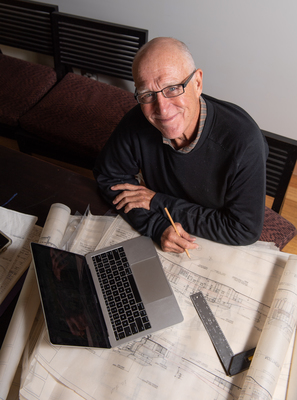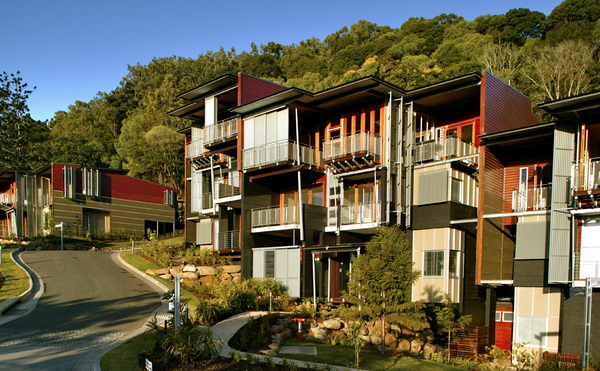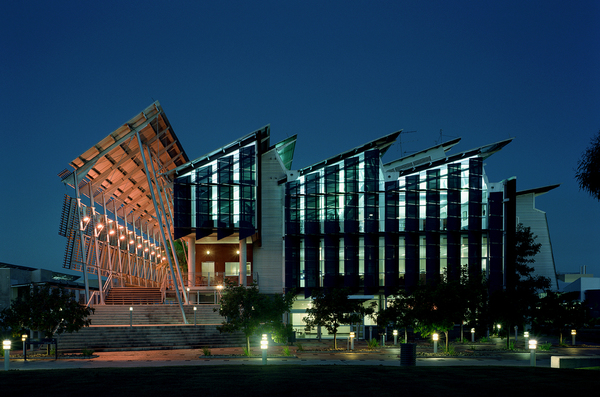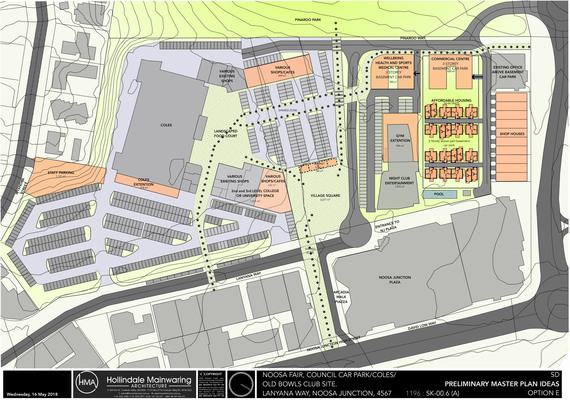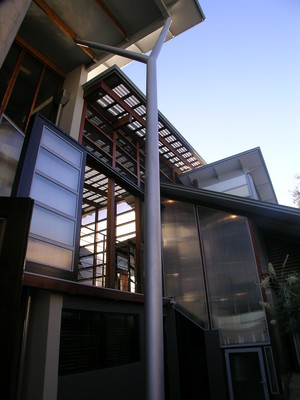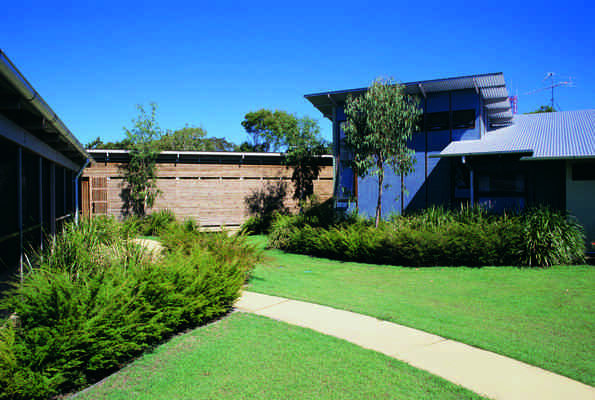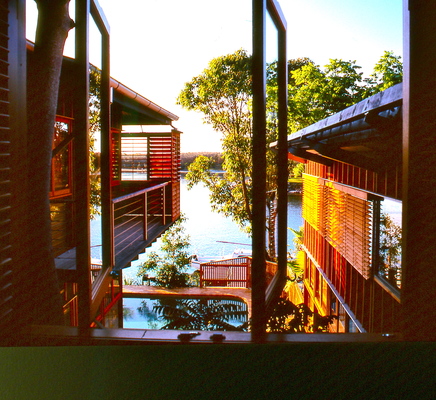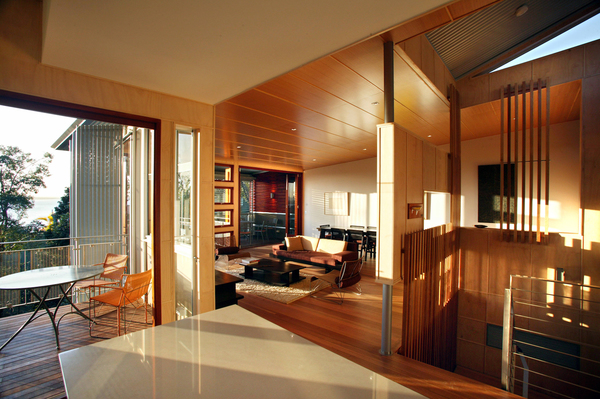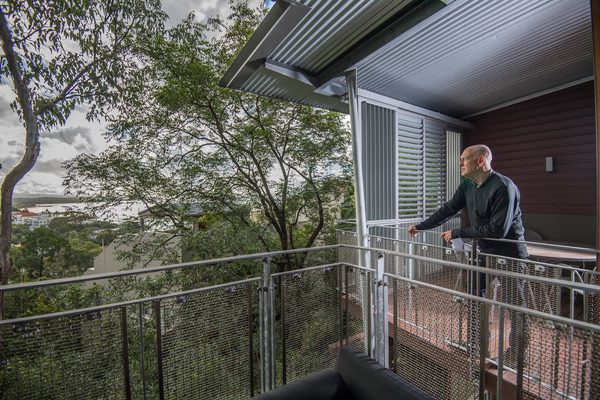By Margaret Maccoll
In social science the built environment is the human-made surroundings. For Noosa award-winning architect John Mainwaring the built environment should blend with the natural environment.
When Mainwaring designed one of his signature developments, Viridian Noosa Residences at Noosa Heads, he had a vision of an Italian village connected by walkways and nestled into Noosa hill. Built on a former banana plantation the surrounding bushland was restored and care taken to retain existing trees. “We had to plot every branch, every tree,” he said. The result is small-scale apartments of minimal environmental impact forming a backdrop to Noosa. An ideal location the apartments have stunning views across Laguna Bay, are a three minute walk to Noosa Main Beach and Hastings Street restaurants, the National Park is its backyard and it provides socio-economic support to Noosa.
“It’s always been the aim of mine to design a building that fits in with the forest,” he said.
For the past 50 years Mainwaring has been at the forefront of Noosa architecture. He has been instrumental in retaining heritage buildings, resisting high rise developments, working with the environment and creating an Australian coastal style that has become synonymous with the area.
Now he has identified an opportunity to recapture some of the Noosa of old at Noosa Junction, revitalise an ageing demographic, introduce stylish affordable housing and incorporate a planned public space similar to a town square which has given an identity to cities across Europe since 500BC. He urged the community as stakeholders in their built environment to consider such a project.
Early days of Noosa development
John Mainwaring sailed his yacht into the former mouth of the Noosa River in the late 1970s. He was living on his boat when he set up business with fellow-architect Gabriel Poole in an A-frame building in Hastings Street.
“I was sailing north for the winter and met up with Gabriel at the Yacht Club,” he said. “He asked if I could come and do some work with him. ‘We should get up to Noosa. There’s something happening up there’” Gabriel told him. “It evolved from there.”
That time in Noosa was “like an incubator” he said.
“People came from all over Australia. There were French and South Americans. There was a real cosmopolitan feel. It was unmaterialistic,” he said.
“There were bohemians, artists, surfers. The attitude from environment to built environment evolved. The other thing that evolved was a cuisine and art culture. We had curb side eating before Brisbane. People didn’t just live in Noosa, they settled in the villages in the hinterland – all the villages gained their own culture.
“The green movement (started by Dr Arthur Harrold) was prominent and even the developers and real estate agents wanted to keep high rise out of the area. As it became more popular people regarded it as an environmental paradise.”
Two of his projects one of which was Noosa International set the tone for the area. High rise was mooted for both projects but it didn’t eventuate and that set the control of heights in Noosa. “We were all escaping high rise and the urban congestion,” he said. “There was an understated ethos for buildings in Noosa.
“It could have been very different.
“When we did Wallace Park some people wanted to put a sports hall on the park so you could see a big building but we moved it to a corner. “It was a philosophy where you couldn’t see the building.”
There were plans mooted to replace the few historic buildings in Noosa with large developments. To prevent this happening Mainwaring initiated a Sunshine Coast branch of the National Trust and Halse Lodge, Wallace House and Mill Point were heritage-listed. Halse Lodge, originally Bayview Guest House, built by Walter Hay is the last remaining timber guest house in south east Queensland still being used for what it was built for, Mainwaring said. In addition to providing scarce affordable accommodation at Noosa Heads the building adds value through its contribution to the area’s diversity, he said.
A changing Noosa
Over the past 50 years Mainwaring has watched Noosa change. The widening of the Bruce Highway to four lanes brought more people to Noosa and increasing real estate prices have restricted buyers to an older and wealthier demographic. “The culture changed and the evaluation paradigm moved into another gear,” he said.
“Real estate prices have skyrocketed and the different demographics have brought in different tastes. There are some extremely wealthy people living here. The irony was they came up here as part of the movement, escaping the city. It was more than a sea change.
Changing demographics have brought changes in architecture.
“It is what it is. It’s change and you can’t have life without change,” he said. “The green movement is so strong here. You’ve got that green control, that height control, the population control but the taste culture has changed a bit. Still the standard of architecture is very good up and down the coast.”
Work expands outside Noosa
Mainwaring’s work boomed with people attracted to his Australian coastal style he said grew out of the fisherman’s shack and beach house. Examples of his architecture can be seen across the shire with stand out buildings such as the Dragon House at Sunshine Beach attracting wide attention.
“We started getting larger projects – projects outside the shire,” he said. “We did the library and the University of the Sunshine Coast.
“I was asked to go to the city to do the Queen Street Mall. Then I got projects up and down the east coast of Australia”.
Mainwaring now works between Noosa, Brisbane and the Gold Coast. He established JMA Architects on the Sunshine Coast in 1985 and in 2016 Hollindale Mainwaring Architecture was formed with colleague Garth Hollindale.
Mainwaring has been the recipient of numerous rewards and acknowledgements including Australia’s top accolade in the industry, the Sir Zelman Cowan Award and an honorary doctorate from the University of the Sunshine Coast.
His company won the Noosa Council Building of the Decade Award for the St Vincent’s Aged Care Facility and a Civic Design Award for merit as design director for the $25 million Queen Street Mall.
He has worked in England and Denmark and served on committees including as Chairman of the Royal Australian Institute of Architects, Sunshine Coast; Councillor at the Cooloola Sunshine Institute of TAFE; President of the Sunshine Coast Branch of the National Trust; Architectural Consultant for the Sippy Downs Town Plan and Chair of the State Government urban design committee overseeing the Sunshine Coast University Hospital.
An avid art collector and philanthropist, John donated his unified private collection to USC, making it available to the public.
A dynamic and diversified future
In his interest to expand diversity in Noosa Mainwaring believes an opportunity exists to create an area to attract a younger group to the region by transforming the unused bowls club at Noosa Junction into a town square, entertainment precinct, health facility and affordable accommodation.
“There’s some serious wealth in Noosa but the population is getting lopsided – it’s an older, wealthy demographic,” he said. “Younger people, who can’t afford to live here, you need to make society tick.”
Studies show town squares act as visual markers that help people navigate a town and contribute to its identity. Becoming popular in small towns across NSW, these shared spaces offer a place for residents to sit and meet and provide a sense of community.
“It could be a gathering space for all sorts of occasions. In Europe that’s what makes the city tick,” he said. “There’s an opportunity to do night time entertainment in the bowls club where the noise is not going to bother anyone.”
“Commercial realities and cultural relevance must work ‘hand in hand’. The rejected Coles proposal lacked potential community place-making. As with any urban design ideas there are always possibilities, synergies opportunities and conflicts.
“There’s a big opportunity to bring back the old Noosa way of life. Already there’s backpackers providing diversity, curb side eating, a bus terminus and The J. All the bits in pieces are in place for a vibrant village.
“This is the last opportunity to create a Noosa Village Square.”

